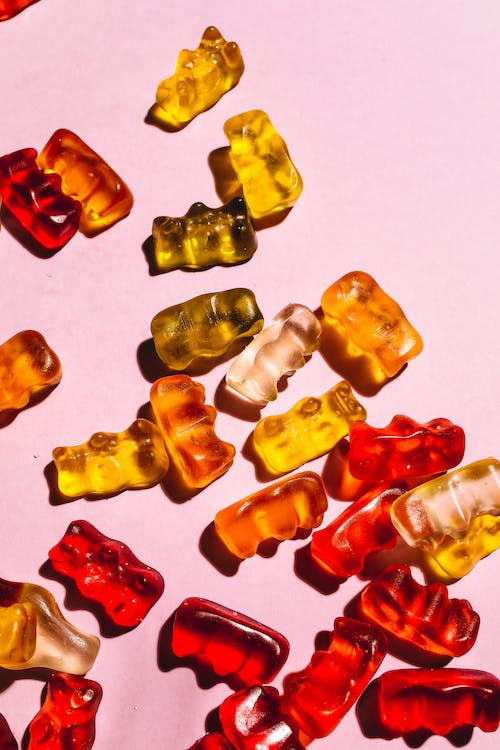Gummy bears are those small, colorful, fruit gum candies that a lot of children and even adults love. They are roughly 2cm or 0.8 in long and are shaped in the form of a bear. It is one of the popular gelatin-based candies that are sold in a variety of shapes and colors. But have you ever wondered where and how the creation of these yummy gummy candies started? And would you believe that it all started with a poor German factory worker, a bag of sugar, and a dream? If you’re curious about the story behind our favorite confection, then we will tell you the history of gummy bears.
History of Gummy Bears
“Dancing Bears”
In 1920, a confectionary worker named Hans Riegel from Bonn Germany became frustrated with his dead-end job and decided to start his own sweets company by making hard, colorless candies. His wife who rode a bicycle was the sole delivery person of his business. He named it Haribo which was a combination of the first two letters of his first and last names and hometown (Hans Riegel of Bonn).
The hard candies that Riegel made sold well at local street fairs but not as well as he hoped. After two years, he thought of a brilliant idea which was to produce a line of soft, gelatin-based, fruit-flavored treats in the shape of dancing bears which was a popular diversion at festivals in Europe. He called it the Dancing Bear. However, while Riegel is often credited as the creator of gummy candy, he just actually improved an already successful, centuries-old, formula.
The two-man family operation had evolved into a factory of 160 by 1930. Then it grew to more than 400 employees by the beginning of World War II, enabling them to create 10 tons of candy each day. However, World War II was a disaster for the company because in 1945, Hans Riegel died and his two sons, Hans Jr. and Paul were imprisoned by the Allied forces.
When they were released, there were only about 30 employees working at their candy company. But they did not let that keep them from rebuilding the empire of their late father. After five years, Haribo had 1,000 workers. Paul oversees the production while Hans Jr. took the CEO position, focusing on sales and marketing. He was also the one who thought of Haribo’s slogan, “Kids and grown-ups love it so, the happy world of Haribo!”.
Gummy Bears World Domination
Haribo became more popular in the years following the war. Before the gummy bears were taller and slimmer but when 1960 came, Haribo started producing the thicker and more kid-friendly littler gummy bears for a broader European market. Haribo trademarked the term “Goldbären”, which means gold and cute, globally in 1975.
As the popularity of the gummy candies grew, professional sugar pushers started creating their own versions of Haribo’s best-selling item. In 1981, the American Jelly Belly Company came out with a gummy bear and in the same year, Trolli launched gummy worms. Haribo, which had been selling Gold-Bears through U.S. distributors then decided to open up its first American office and they have chosen Baltimore for it. That branch is still open today.
After opening their branch in the United States, debates began over which was the superior Gold-Bear: American or German? A lot of people insist to this day that the German version of the gummy candy is better because they are more flavorful. But there are also some who prefer other brands such as Trolli’s neon-colored worms. The wide range of public opinion might have been the reason why there are no legal disputes over the origin or image of the gummy bear that has been recorded.
But Haribo still has secured its status as one of the leading gummy manufacturers in the world, producing 100 million Gold-Bears every day. Haribo did not stick to just making gummy bears because among the top ten most popular gummy products sold by their company are gummy frogs, gummy peaches, gummy cola bottles, and gummy raspberries.
As the years passed, gummy’s have secured a place in pop culture. There were even movies and cartoons about them. There was also a rumor that the 1985 Disney series, “The Adventures of the Gummi Bears” was made because the son of former CEO Michael Eisner had an affinity for the treats.
Aside from the famous gummy bears, there are also gummy fast foods, gummy body parts to vegan, gelatin-free sour gummy worms to gummy vitamins that are created, which are edible outcomes of our nearly century-long obsession with gummy treats.
Ingredients and Production of Gummy Bears
Gummy bears are traditionally made using a mixture of sugar, glucose syrup, starch, flavoring, food coloring, citric acid, and gelatin. But its recipes vary because there are also organic ones that are suitable for vegetarians. They are also made with bovine, porcine, or piscine gelatin which is not suitable for vegetarians and vegans.
When producing gummy bears, a specialized machine called a starch mogul is used. The shape of the gummy bear is stamped into a tray filled with powdered starch. Then, the hot, liquid mixture is poured into the shapes in the starch and is cooled overnight. When the mixture has set, the candies will be removed and packaged. The molders of the gummy bears are open on top so that only the bear’s front is formed while the back remains flat.
Of all the gummy candies available today, gummy bears still remain as the most popular among them. But it’s not really about the movies, cartoons, or even the taste or chews that makes people love them. It’s simply because they are just so adorable and there’s no other candy that is as cute as a gummy bear.

